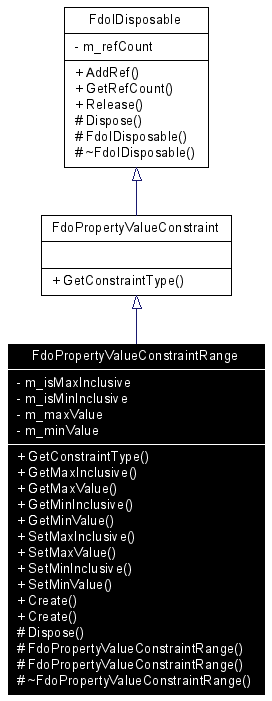
| FDO API Reference | Feature Data Objects |
#include <PropertyValueConstraintRange.h>
Inherits FdoPropertyValueConstraint.
Inheritance diagram for FdoPropertyValueConstraintRange:

Definition at line 38 of file PropertyValueConstraintRange.h.
Public Member Functions | |
| virtual FDO_API FdoPropertyValueConstraintType | GetConstraintType () |
| Returns FdoPropertyValueConstraintType_Range type. | |
| FDO_API bool | GetMaxInclusive () |
| Returns a bool to indicate if the maximum value is inclusive or exclusive. This is the difference between <= and <. This is a boolean type where true means inclusive. | |
| FDO_API FdoDataValue * | GetMaxValue () |
| Get the maximum allowed value. The type of this is the same as the type of the property. E.g. if the property is int32, then this value is int32. | |
| FDO_API bool | GetMinInclusive () |
| Returns a bool to indicate if the minimum value is inclusive or exclusive. This is the difference between >= and >. This is a boolean type where true means inclusive. | |
| FDO_API FdoDataValue * | GetMinValue () |
| Get the minimum allowed value. The type of this is the same as the type of the property. E.g. if the property is int32, then this value is int32. | |
| FDO_API void | SetMaxInclusive (bool value) |
| Returns a bool to indicate if the maximum value is inclusive or exclusive. This is the difference between <= and <. This is a boolean type where true means inclusive. | |
| FDO_API void | SetMaxValue (FdoDataValue *value) |
| Set the maximum allowed value. | |
| FDO_API void | SetMinInclusive (bool value) |
| Set the minimum value to inclusive or exclusive. This is the difference between >= and >. | |
| FDO_API void | SetMinValue (FdoDataValue *value) |
| Set the minimum allowed value. | |
Static Public Member Functions | |
| static FDO_API FdoPropertyValueConstraintRange * | Create (FdoDataValue *minValue, FdoDataValue *maxValue) |
| Constructs and populates an instance of an FdoPropertyValueConstraintRange. | |
| static FDO_API FdoPropertyValueConstraintRange * | Create () |
| Constructs an empty instance of an FdoPropertyValueConstraintRange. | |
Protected Member Functions | |
| virtual void | Dispose () |
| Dispose this object. | |
| FdoPropertyValueConstraintRange (FdoDataValue *minValue, FdoDataValue *maxValue) | |
| FdoPropertyValueConstraintRange () | |
| Constructs a default instance of a FdoPropertyValueConstraintRange. | |
| virtual | ~FdoPropertyValueConstraintRange () |
| Comments or suggestions? Send us feedback. |